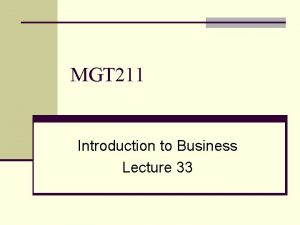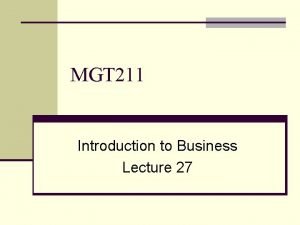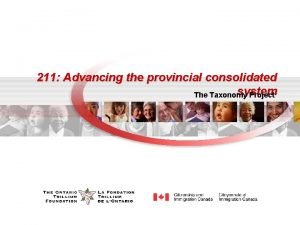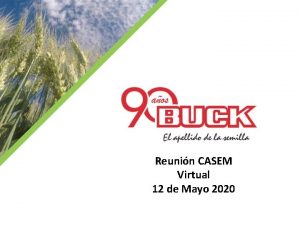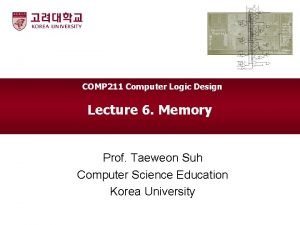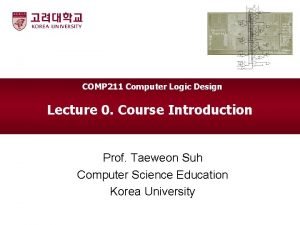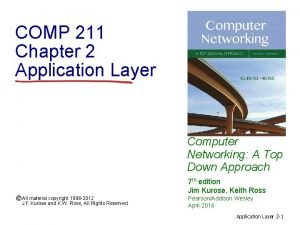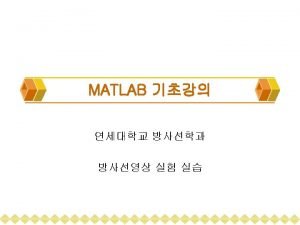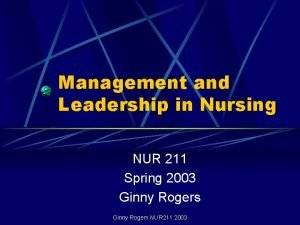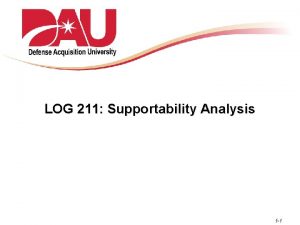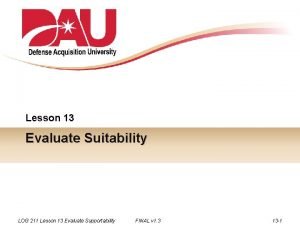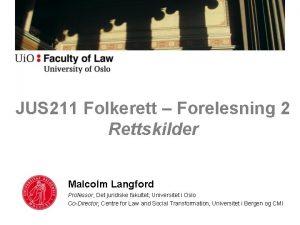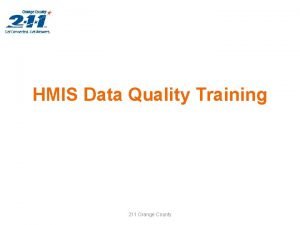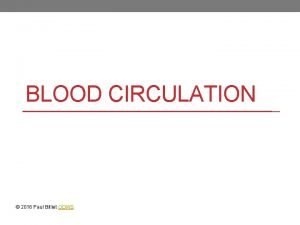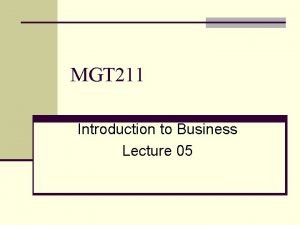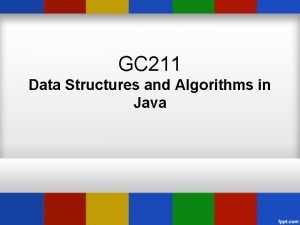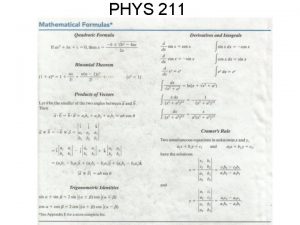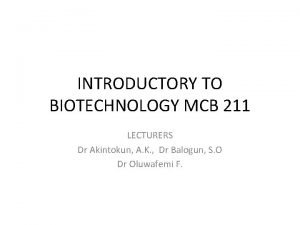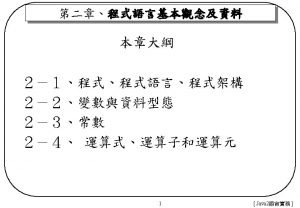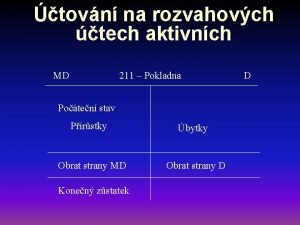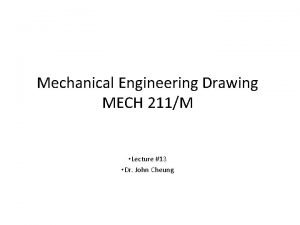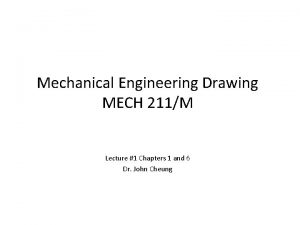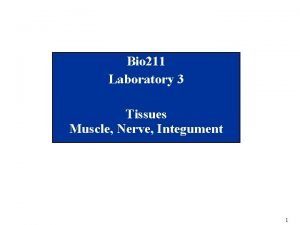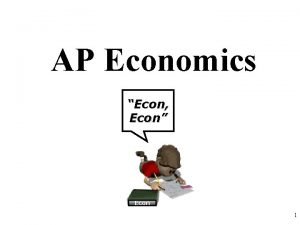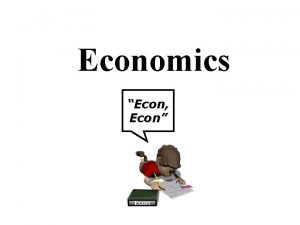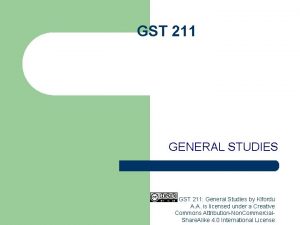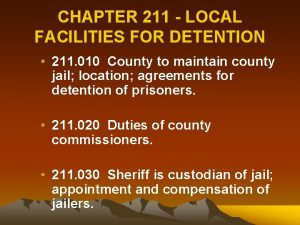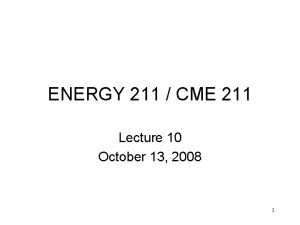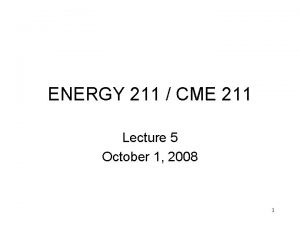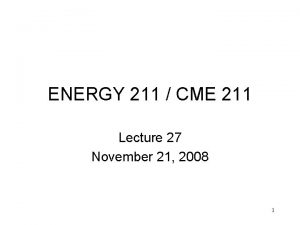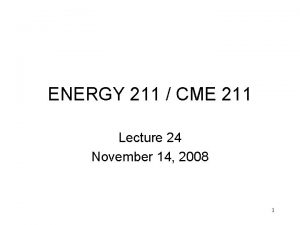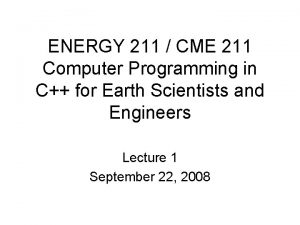ECON 211 ELEMENTS OF ECONOMICS I Session 2















































- Slides: 47

ECON 211 ELEMENTS OF ECONOMICS I Session 2 – Scarcity, Choice and Economic Systems Lecturer: Dr. (Mrs. ) Nkechi S. Owoo, Department of Economics Contact Information: nowoo@ug. edu. gh College of Education School of Continuing and Distance Education 2014/2015 – 2016/2017

Session Overview • This session deals with three topics: – the concept of opportunity cost – the problem of resource allocation – the different types of economic systems. • All three topics arise from the central theme of scarcity. Slide 2

Session Outline The key topics to be covered in the session are as follows: • The Concept of Opportunity Cost • Economic Systems – Resource Allocation – Resource Ownership Slide 3

Reading List • Hall and Lieberman – Chapter 2 Slide 4

Topic One THE CONCEPT OF OPPORTUNITY COST Slide 5

The Concept of Opportunity Cost • Opportunity cost of any choice – This is what we must forego when we make that choice – It is called the opportunity cost because we give up the opportunity to have other desirable things when we choose to have something else. – It is the most accurate and complete concept of cost • Should be used when making or analyzing decisions – It summarizes everything you actually sacrifice in making the choice 6

Opportunity Cost for Individuals • Every action we take as individuals uses up scarce money, scarce time, or both • The money or time could have been used for other things that you value • Therefore, the true cost of any choice made (i. e. the opportunity cost) is everything you actually sacrifice in making the choice • For example, as a student, you are presently spending some time to read these session slides for Econ 211. What is the opportunity cost of the time spent (e. g. 1 hour) in this activity? • This would be other activities that you could be engaged in within the 1 hour period that you may spend reading these slides – E. g. Going to a movie, having breakfast/lunch/dinner with friends, cooking, doing laundry, etc 7

Opportunity Cost for Individuals • The opportunity cost of a choice includes – Explicit cost • The Ghana cedis sacrificed - and actually paid out for a choice – Implicit cost • The value of something sacrificed when no direct payment is made • In examining the opportunity cost of attending a 4 year university, opportunity cost may involve both tuition fees (explicit costs) and lost wages (implicit cost) 8

Illustration of The Concept of Opportunity Cost: Opportunity Cost of University Education Expenses Ghc Tuition and Fees 3, 000 Books and supplies 1, 000 Room and Board 5, 000 Transportation and other expenses 4, 000 Total Out-of-pocket costs 13, 000 • What is opportunity cost of attending university? – Explicit or out-of-pocket costs • Not an accurate dollar measure of opportunity costs. Why?

The Concept of Opportunity Cost: Opportunity Cost of University Education • Ghc 13, 000 total includes some expenses that are not part of opportunity cost of college – Room and board and transportation costs are something you would need no matter your choice – Something would be sacrificed for room and board whether you go to university or not – On the contrary, expenses like tuition and fees are made only when you attend university, and so are part of (explicit) costs of attending university • Attending university also has implicit costs – time • What would you be doing if you weren’t in school? • Summing *explicit and implicit costs gives total opportunity cost of attending university

Opportunity Cost and Society • For an individual, opportunity costs arise from the scarcity of time or money • For society, opportunity costs arise from the scarcity of society’s resources • Our desire for goods is limitless – Limited resources to produce them • To produce more of one thing – Society must shift resources away from producing something else • Develop a model- Production Possibilities Frontier- to illustrate concept of society’s opportunity costs 11

Production Possibilities Frontiers • Production Possibilities Frontier (PPF) – A curve showing all combinations of two goods that can be produced with the resources and technology available • Assumptions – Fixed resources – Fixed technology – Only two goods produced in economy • Tabular illustration 12

Production Possibilities Frontiers Points Tank Production (number per year) Wheat Production (Bushels per year) A 0 1000000 B 1000 950000 C 2000 850000 D 3000 700000 E 400000 F 5000 0 – Quantitative measure of opportunity cost • Opportunity cost of having more of one good measured in the units of the other good that must be sacrificed • E. g. the opportunity cost of this society moving from 0 production of tanks per year to 1000 tanks per year would be 50, 000 bushels of wheat the society must forego 13

Production Possibilities Frontiers • The Production Possibilities Frontier Bushels of Wheat per Year 1, 000 950, 000 850, 000 all resources are used for wheat A B C D 700, 000 500, 000 400, 000 Moving from point A to point B requires shifting resources out of wheat and into tanks W E all resources are used for tanks F 100, 000 200, 000 300, 000 400, 000 500, 000 Number of Tanks per 14 Year

Increasing Opportunity Cost • The law of increasing opportunity cost – The more of something we produce, the greater the opportunity cost of producing even more of it – Explains • The concave (upside-down bowl) shape of the PPF • Why the PPF becomes steeper as we move rightward and downward • Tabular illustration 15

Increasing Opportunity Costs Points Tank Production (number per year) Wheat Production (Bushels per year) Opportunity Cost of Tank Production A 0 1000000 - B 1000 950000 C 2000 850000 100000 D 3000 700000 150000 E 400000 300000 F 5000 0 400000 – The continuous production of an additional 1000 tanks leads to greater and greater bushels of wheat that must be foregone – Why? Because most resources by their nature, are better suited to certain purposes than to others – Production of first 1000 tanks used those resources that were most suited to tank production leading to a low opportunity cost; with increased production of tanks, resources better suited to wheat production are moved into tank production, leading to greater opportunity costs 16

The Production Possibility Frontier • Society must always give up the production of a good or service, in exchange for producing something else • There a few seemingly violations of this statement, and these occur in situations where an economy is operating inside the PPF, as a result of – Productive inefficiency – Recession 17

Productive Inefficiency • All resources are being used, but not in the most productive way • For example, instead of those individuals most suited to tank production being engaged in this activity, they may have been engaged as wheat farmers; while those workers most suited to wheat production have been engaged in the production of tanks. • This leads to less than optimal production, and the economy operates at a point inside its PPF • In this situation therefore, it becomes possible to increase the production of one good without decreasing production of the other good – Indeed, it may be possible to increase the production of both goods within the economy by properly re-allocating workers to activities in which they are best-suited. 18

Recessions • Another reason why an economy may operate inside its PPF is a recession – This refers to a slowdown in overall economic activity • During a recession, many resources are idle and there is widespread unemployment • Factories may be shut down – Land capital are not being used • Ending a recession – Move the economy from a point inside its PPF to a point on its PPF 19

Recessions • Production and Unemployment Military Goods per Period 1. Before WWII the United States operated inside its PPF B 2. then moved to the PPF during the war. Both military and civilian production increased A Civilian Goods per Period 20

Economic Growth • We may also be able to increase the production of more of both goods in the event of the growth of the economy. • In modeling the PPF, we assumed fixed resources and technology • Access to increased resources of better technology may increase the economy’s productive capacity and therefore lead to the economy producing more of both goods • This may be illustrated by an outward shift of the PPF curve 21

Economic Growth • Factors contributing to economic growth – Increase in the quantities of available resources • Physical capital • Human capital – Technological change Slide 22

Economic Growth • A change in factors that favour the production of wheat may lead to an upward shift of the PPF along the Wheat Production axis • See Figure on next slide – An upward shift of the PPF may lead to an increase in wheat production only (point D to point H); an increase in tank production only (point D to point J); or an increase in both wheat and tank production (point D to any point between points H and J). Slide 23

Economic Growth • Economic Growth and the PPF (a) Wheat (bushels per year) 1, 200, 000 1, 000 700, 000 Additional resources or technological advance affect only the wheat production A’ H A J D F 3, 000 5, 000 Tanks per Year 24

Economic Growth • A change in factors that favour the production of tanks may lead to a rihtward shift of the PPF along the tank production axis • See Figure on next slide – A rightward shift of the PPF may lead to an increase in wheat production only; an increase in tank production only; or an increase in both wheat and tank production. Slide 25

Economic Growth • Economic Growth and the PPF (b) Wheat (bushels per year) 1, 200, 000 1, 000 A Additional resources or technological advance affect only the tank production D 5, 000 6, 000 Tanks per Year 26

Economic Growth • A change in factors that favour both the production of wheat and tanks may lead to a parallel shift of the PPF along both the Wheat and Tank Production axis • See Figure on next slide – A parallel shift of the PPF may lead to an increase in wheat production only; an increase in tank production only; or an increase in both wheat and tank production. Slide 27

Economic Growth • Economic Growth and the PPF (c) Wheat (bushels per year) Additional resources or technological advance affect the production of both goods 1, 200, 000 1, 000 D 5, 000 6, 000 Tanks per Year 28

Topic Two ECONOMIC SYSTEMS: RESOURCE ALLOCATION RESOURCE OWNERSHIP Slide 29

Economic Systems • Economic system – This describes the way our economy is organized 30

Resource Allocation • Ten thousand years ago, the Neolithic revolution began and human societies switched from hunting and gathering to farming and simple manufacturing • Human beings’ wants also became more sophisticated over time • These developments in human wants and the capacity for production has given rise to three (3) important questions: 1. Which goods and services should be produced with society’s resources? 2. How should they be produced? 3. Who should get them? 31

Resource Allocation • Which goods and services should be produced with society’s resources? – Should we produce more health care or more movies? – More goods for consumers or more capital goods for businesses? • Where on the PPF should the economy operate? Slide 32

Resource Allocation • How should these goods and services be produced? – Most goods and services can be produced in a variety of ways, using various combinations of capital and labour – Illustration • There a number of ways to dig a ditch 1. No capital at all; dozens of workers digging with their bare hands 2. A small amount of capital (e. g. workers use a shovel) and less labour 3. A power trencher with only 1 or 2 workers to manage it Slide 33

Resource Allocation • Who should get the goods and services that have been produced? – There are so many ways to divide people into groups • Men and women; Rich and poor; Skilled and unskilled; Workers and business owners; families and single people; young and old, etc • How should the products of the economy be distributed among these groups of people, and among people within each group? – Determining who gets the economy’s output is the most controversial aspect of Resource Allocation – The next section discusses the various methods of resource allocation…. Slide 34

Methods of Resources Allocation • Throughout history, every society has relied on one of three mechanisms for allocating resources 1. Traditional Economy 2. Command Economy (Centrally-Planned) 3. Market Economy 35

Methods of Resources Allocation • Traditional Economy • In the traditional system, resources are allocated based on the long-lived practices of the past. – Young men follow their fathers’ occupation, which was typically farming, hunting, fishing and tools-making. – Young women also followed in their mothers’ footstepstypically, cooking, mending and fieldwork. • Tradition was the dominant mode of resource allocation for most of human history and there were few changes in modes of production from year to years, other than those imposed by the vagaries of the weather. 36

Methods of Resources Allocation • Traditional Economy – Tradition continues to be a strong determining factor in many tribal societies and small villages in parts of Africa, South America, Asia and the Pacific. • Few, small, isolated, self-sufficient communities retaining the traditional system can also be found in isolated parts of the Canadian Arctic, the Himalayas, the Amazon Jungle, and isolated parts of Papua New Guinea. – Typically, traditional methods of production are handed down by village elders, and the distribution of goods and services are governed by traditional principles of fairness. – The concept of private property is not well-defined and properties are most often held in common, such as common grazing land. – Economies which are governed by traditions of the past tend to be more stable and predictable. – There is however, one important drawback: these economies do not grow. This is because everyone is locked into the traditional ways of production, leaving little room for innovation and technological change. – Traditional economies are therefore likely to be stagnant economies. 37

Methods of Resources Allocation • Command Economy (Centrally-Planned) – In a command system (also called centrally-planned economies), some central authority determines economic behaviour. – This central authority makes decisions relating to what to produce, how to produce it and who gets to consume it. – Centralized decision-makers often lay down elaborate and complex plans for the behaviours that they wish to impose. – These plans often exist on a rolling basis- they are continually change to take advantage of changing information such as labour supply, technological innovation and people’s tastes for goods and services. – Planners must therefore be able to reasonably accurately predict the future. – About thirty years ago, over a third of the world’s economy was centrally planned. • Examples included the former Soviet Union, Poland, Romania, Bulgaria, Albania, China, and many more. – In more recent times, beginning in the late 1980’s, the number of centrally planned economies is greatly reduced. – Even in countries where central planning is still dominant, such as in China, rapidly increasing amounts of market determination are being accepted and encouraged. 38

Methods of Resources Allocation • Market Economy – In a pure market system, millions of consumers decide what products to buy, and in what quantities. • A large number of firms produce these products and buy the inputs that are needed to make them. • Individual decisions collectively determine the nation’s allocation of resources between competing uses and the distribution of its output among various citizens. – In a market economy, instead of following long-held traditions or commands from above, people are largely free to do what they want with the resources at their disposal. • Which goods and services are produced? The ones that the people choose to produce. • How are they produced? However producers choose to produce them. • Who gets the goods and services? Anyone who chooses to buy them. Resources are allocated in markets, through the medium of prices. – It is important to note, however, that in a market economy, freedom of choice is constrained by the resources that individuals own. • Therefore, we do not all start at the same place in the human race. Some of us may have inherited great intelligence, talent or beauty, and others, such as the children of professionals, are born into a world with helpful personal contacts. – In a market economy, therefore, those who control more resources will have more choices open to them, than those who do not. 39

Resource Ownership • Another important feature of an economic system is how resources are owned • The owner of a resource determines how it can be used and receives income when others use it • There are three main modes of resource ownership 1. Communism 2. Socialism 3. Capitalism 40

Resource Ownership • Communism – Resources are owned by everyone – No-one imposes restrictions on the use of these resources – There are no good examples of communism on a large/ national scale, largely because individuals often have conflicts about how resources should be used – There are some small-scale illustrations of communism, however • Traditional villages may maintain communal ownership of land or cattle • In individuals’ homes, most families operate on the principle of communal ownership i. e. the TV, food in the fridge, etc are treated as if owned jointly Slide 41

Resource Ownership • Socialism – Here, the state owns most of the resources – A good example is the former Soviet Union, where the state owned all the land capital equipment in the country Slide 42

Resource Ownership • Capitalism – Here, most resources are owned by private individuals – The US is said to be the most capitalistic country in the world – Although there are some features of communism and socialism in the US economy, the dominant feature is one of capitalism, where resource owners keep most of the income that they earn from supplying resources, and they have broad freedom in deciding how these resources are used Slide 43

Types of Economic Systems • An economic system is composed of two features: a mechanism for allocating resources and a mode of resource ownership • These are illustrated in the figure on the next slide… 44

Types of Economic Systems • Types of Economic Systems Resource Allocation Private Market Command Market Capitalism Centrally Planned Capitalism Market Socialism Centrally Planned Socialism Resource Ownership State 45

Types of Economic Systems • Market Capitalism – Resources are allocated primarily by the market and owned primarily by private individuals – E. g. North America, Western Europe, most countries in Asia, Latin America and Africa • Centrally Planned Socialism – Resources are mostly allocated by command mostly owned by the state – E. g. former Soviet Union • Centrally Planned Capitalism – Resources are owned by private individuals, yet allocated by command – E. g. in the recent past, Sweden and Japan • Market Socialism – Resources are owned by the state, yet allocated by the market mechanism – E. g. Hungary and Yugoslavia in the 1950 s and the 1960 s Slide 46

References • Economics: Principles and Applications: Hall R. E. and Lieberman M. (2008), Thomson/ South Western (4 th Edition) Slide 47
 School of business and economics maastricht
School of business and economics maastricht Elements of mathematical economics
Elements of mathematical economics Opwekking 211
Opwekking 211 Miller indices 211
Miller indices 211 211 snohomish county
211 snohomish county Poli 211
Poli 211 Physics 211 exam 1
Physics 211 exam 1 Legea 211 2011
Legea 211 2011 Luyana211
Luyana211 A product can be
A product can be Is 211 nationwide
Is 211 nationwide Csce 211
Csce 211 211 la taxonomy
211 la taxonomy Buck resplandor
Buck resplandor Csce 211
Csce 211 Comp 211
Comp 211 Comp 211
Comp 211 Comp 211
Comp 211 211 org md
211 org md 매트랩 subplot
매트랩 subplot Nur 211 final exam
Nur 211 final exam Supportability analysis training
Supportability analysis training Asoe model
Asoe model Jus 211
Jus 211 211 orange county
211 orange county Csce 211
Csce 211 The monk lines 169-211 characterization
The monk lines 169-211 characterization Bio 211
Bio 211 Mgt 211
Mgt 211 Gd 211
Gd 211 Gc 211
Gc 211 21 cfr 211 training requirements
21 cfr 211 training requirements Cu 211
Cu 211 Csce 211
Csce 211 Physics 211
Physics 211 Section 211
Section 211 Mcb 211
Mcb 211 Gd 211
Gd 211 Java 211
Java 211 Economic 211
Economic 211 Tabulková předvaha
Tabulková předvaha Joanna bogin
Joanna bogin Backstop mechanical engineering
Backstop mechanical engineering Mech 211
Mech 211 Point estimate of population mean
Point estimate of population mean Clemson ece lab manual
Clemson ece lab manual Integument
Integument Psych 211
Psych 211








